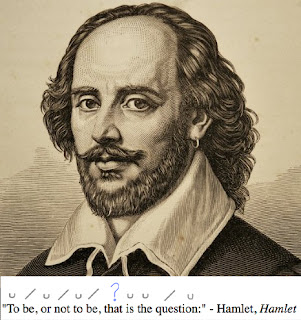The Meanings of Shakespeare's Famous Insults
Shakespeare is known first and foremost for his fiery insults. But what do these insults actually mean? Let's take a closer look at seven of Shakespeare's best insults below.
1. Coxcomb
The insult "coxcomb" can be found in ten of Shakespeare's plays: All's Well That Ends Well, The Comedy of Errors, Henry V, King Lear, Love's Labour's Lost, The Merry Wives on Windsor, Much Ado About Nothing, Othello, The Taming of the Shrew, and Twelfth Night. It refers to a vain and conceited man, or a dandy. It is also the name for a jester's cap––so it can be used to call someone a fool (as in King Lear, Act I, Scene 4, Lines 90-103).
2. Biting one's thumb
This physical insult comes from Romeo and Juliet, Act 1, Scene 1 in a show-down between Sampson and Abram (Lines 43-52). The simple gesture soon causes a fight to break out in the streets. From the context, it is clear that biting one's thumb at someone else is equivalent to giving them "the finger" in the modern day. The origins of the gesture have been traced back to Italy in the 12th Century. In her book How to Behave Badly in Elizabethan England, Ruth Goodman finds that a modern version of this gesture––which involves putting the thumb against the teeth and flinging the thumb in the direction of the person one wants to insult––is still in use in parts of Italy today.
3. Egg
A favorite among young readers of Macbeth, "What, you egg! [Stabs him.]" (Act IV, Scene 2, Line 91) is one of Shakespeare's most bizarre insults. As far as scholars can tell, "egg" meant the same thing in Shakespeare's day as it does today. So Shakespeare was likely the first to use "egg" as an insult. In this scene, which is full of bird imagery, the First Murderer kills Lady Macduff's son. The Murderer calls the son an "egg" to indicate that, like a bird that has not hatched yet, he is young and helpless––in other words, easy prey.
4. Lily-liver'd
The insult "lily-liver'd" (full form: "lily-livered") appears in both Macbeth and King Lear as a way to call someone a coward. This compound insult evokes the pale white color of the lily flower, and the prevailing beliefs about the role of the liver, which date back to the Middle Ages. The liver was thought to be the seat of courage in the human body. Having a pale or white (bloodless) liver meant lacking courage. A variation of this insult can be found in The Merchant of Venice: "Who, inward search'd, have livers white as milk" (Act III, Scene 2, Line 86).
5. Knave
This insult is very common in Shakespeare––it occurs 197 times across his plays. It possesses two main meanings: 1) a male slave, and 2) a dishonest, untrustworthy, or deceitful person.
6. Juggler
A "juggler" refers to a trickster––often a conjurer, like Pinch in The Comedy of Errors (Act V, Scene 1, Line ?) or a two-faced person, like Hermia accuses Helena of being in A Midsummer Night's Dream (Act III, Scene 2, Line 282).
7. Canker-blossom
In A Midsummer Night's Dream, Hermia calls Helena a "canker-blossom" (Act III, Scene 2, Line 282). A "canker" is a contagious fungus or disease that causes plants to rot. A "blossom" is, of course, a flower. So Hermia is accusing Helena of destroying the blossoming flower of her love with Lysander––or maybe even of contaminating love or beauty itself.
 |
| Image credit: Victorian Illustrated Shakespeare Archive by Michael John Goodman |



Comments
Post a Comment
All comments are moderated by the Green-Eyed Blogger to avoid spam. If you do not see your comment right away, do not worry; it is simply undergoing our routine moderation process.